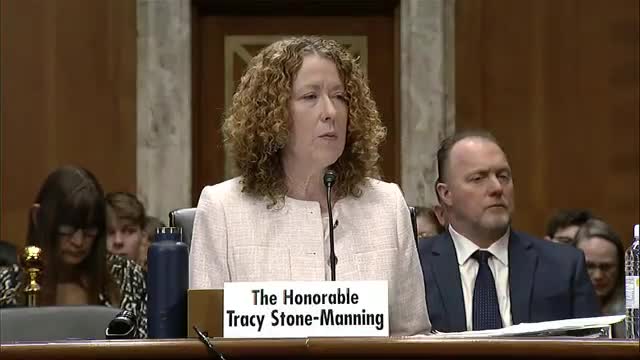BLM faces backlash over critical mineral supply chain delays
June 13, 2024 | Energy and Natural Resources: Senate Committee, Standing Committees - House & Senate, Congressional Hearings Compilation

This article was created by AI summarizing key points discussed. AI makes mistakes, so for full details and context, please refer to the video of the full meeting. Please report any errors so we can fix them. Report an error »

In a recent government meeting, discussions centered on the Bureau of Land Management's (BLM) role in renewable energy development, critical mineral supply chains, and the management of public lands, particularly in Alaska.
The BLM emphasized its collaboration with state fishing game agencies to guide development while adhering to land health standards. The agency's new public lands rule aims to facilitate renewable energy projects by allowing mitigation leasing on public lands, which is expected to enhance conservation efforts and provide a consistent framework for energy companies to offset their environmental impacts.
However, concerns were raised regarding the U.S. falling behind in securing critical minerals essential for the transition to a clean energy economy. The BLM acknowledged the challenges posed by the 1872 Mining Law, which limits its ability to proactively pursue mineral projects. Despite these constraints, the agency has permitted five critical mineral mines during the current administration, including a significant lithium project expected to supply 20% of the world's lithium.
Senator Lisa Murkowski expressed frustration over perceived restrictions on development in Alaska, citing the BLM's recent decisions that she believes undermine energy security and economic stability in her state. She specifically criticized the agency's handling of the Central Yukon Resource Management Plan and the failure to lift Public Land Order 5150, which she argues is crucial for the Trans-Alaska Pipeline System. Murkowski's concerns reflect a broader sentiment among Alaskan officials who feel that the BLM's actions are detrimental to local economies and energy independence.
In response, BLM officials acknowledged the importance of balancing environmental protection with resource development but indicated that workload and timing issues have delayed progress on certain projects. The agency is working on a recreation blueprint to manage the increasing public interest in outdoor activities on BLM lands, which saw a record 82 million visitors last year.
The meeting highlighted the ongoing tension between environmental stewardship and resource development, particularly in regions like Alaska, where economic interests and environmental policies often clash. As the BLM navigates these complex issues, the agency's ability to balance competing demands will be critical for future energy security and conservation efforts.
The BLM emphasized its collaboration with state fishing game agencies to guide development while adhering to land health standards. The agency's new public lands rule aims to facilitate renewable energy projects by allowing mitigation leasing on public lands, which is expected to enhance conservation efforts and provide a consistent framework for energy companies to offset their environmental impacts.
However, concerns were raised regarding the U.S. falling behind in securing critical minerals essential for the transition to a clean energy economy. The BLM acknowledged the challenges posed by the 1872 Mining Law, which limits its ability to proactively pursue mineral projects. Despite these constraints, the agency has permitted five critical mineral mines during the current administration, including a significant lithium project expected to supply 20% of the world's lithium.
Senator Lisa Murkowski expressed frustration over perceived restrictions on development in Alaska, citing the BLM's recent decisions that she believes undermine energy security and economic stability in her state. She specifically criticized the agency's handling of the Central Yukon Resource Management Plan and the failure to lift Public Land Order 5150, which she argues is crucial for the Trans-Alaska Pipeline System. Murkowski's concerns reflect a broader sentiment among Alaskan officials who feel that the BLM's actions are detrimental to local economies and energy independence.
In response, BLM officials acknowledged the importance of balancing environmental protection with resource development but indicated that workload and timing issues have delayed progress on certain projects. The agency is working on a recreation blueprint to manage the increasing public interest in outdoor activities on BLM lands, which saw a record 82 million visitors last year.
The meeting highlighted the ongoing tension between environmental stewardship and resource development, particularly in regions like Alaska, where economic interests and environmental policies often clash. As the BLM navigates these complex issues, the agency's ability to balance competing demands will be critical for future energy security and conservation efforts.
View full meeting
This article is based on a recent meeting—watch the full video and explore the complete transcript for deeper insights into the discussion.
View full meeting